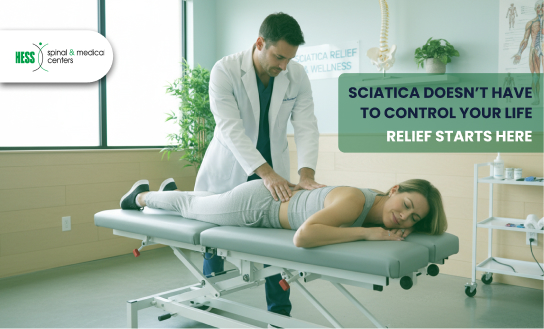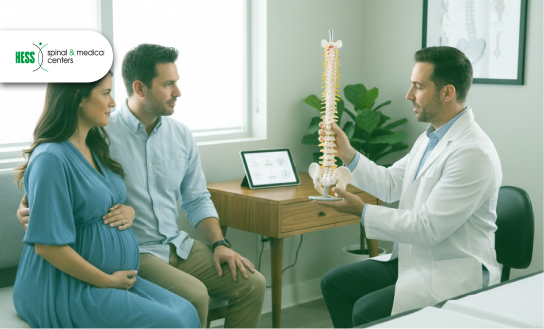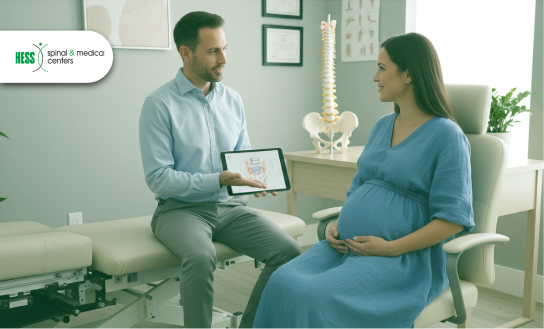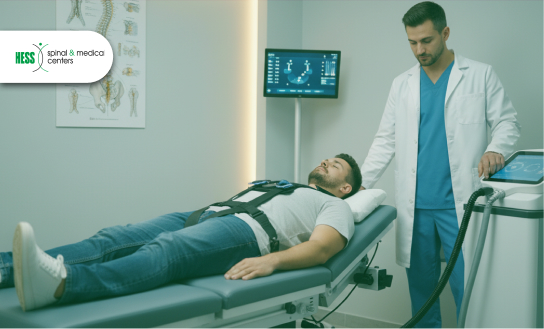
Blogs
Our Recent Blog Post

How Effective is Chiropractic Care for Sciatica?
There are days when the body feels like an unfamiliar and unreliable stranger. The pain starts in the lower back, deep and nagging, then takes a cruel detour down your leg. It tightens like a vice, sharpens like a blade, and just when you think it’s easing, it returns more persistent than before.
You try to stretch. You rest. You pop a pill or two. Maybe you wait for it to disappear, like so many things do if you’re just patient enough. However, sciatica doesn’t care about patience. It doesn’t care that you’ve got work, or kids, or sleep you desperately need. It just stays.
And so, you wonder: is there a way to quiet this nerve without surgery, without sedation and without giving in? That question isn’t just medical. It’s personal. And the answer might start in a place most people wouldn’t expect
1) Why Does Sciatica Hurt So Much?
Sciatica isn’t just back pain. It’s nerve pain—deep, radiating, and often unforgiving. It starts in the lower spine and follows the path of the sciatic nerve, the longest nerve in your body, running down through your hips, buttocks, and legs. When that nerve gets compressed or irritated, the result is pain that can shoot, burn, or throb anywhere along its route.
Now, what’s pressing on the nerve in the first place? That’s the real culprit. In many cases, it’s a herniated disc—a cushion between your spinal bones that’s slipped out of place and is pinching the nerve. Sometimes it’s spinal stenosis, a narrowing of the spinal canal that crowds the nerve roots. And in others, it’s the piriformis muscle deep in your glutes tightening and clamping down on the nerve like a vise.
“Sciatica affects up to 40% of people at some point in their lives.”
Source— Harvard Health Publishing
That’s not a small number. And for something that common, it deserves more than a wait-it-out approach or a quick prescription. It deserves a plan that gets to the source.
2) What Does a Sciatica Chiropractor Actually Do?
A sciatica chiropractor’s job is to figure out why the nerve is inflamed and then create space for the body to heal itself safely, gently, and strategically.
That starts with a full-body assessment: not just where the pain is, but how you move, stand, and sit. Because sciatica rarely happens in isolation. It’s usually the result of something being out of balance like a misaligned vertebra, a tight muscle, or a disc that’s putting pressure where it shouldn’t.
From there, your chiropractor builds a tailored treatment plan to relieve that pressure and restore function. That might include:
Spinal manipulation, where targeted adjustments improve alignment and mobility
Joint mobilization, using gentle movements to loosen restricted areas
Soft tissue therapy, to release tension around the nerve and improve blood flow
It’s highly specific, often layered with exercises and lifestyle adjustments that support healing well beyond the treatment table. And when it’s done right? It relieves pain and it helps keep it from coming back.
3) Does Chiropractic Care for Sciatica Really Work?

Let’s get to the heart of it—does it actually help? Not “maybe,” not “it depends,” but real, measurable relief.
Chiropractic care is rooted in the idea that when your spine moves the way it’s supposed to, nerves have the space they need to function pain-free. And yes, that theory holds up in the data.
One long-term study looked at patients with confirmed sciatica. Half of them received spinal adjustments, and the other half underwent surgery. The results?
“60% of sciatica patients who received spinal manipulation experienced the same level of relief as those who had surgery.”
Source —Spine Journal
That’s a pretty big deal for people trying to avoid going under the knife.
Even beyond sciatica-specific cases, chiropractic care shows strong results for related pain patterns. Acute low back pain, for example, often overlaps with early sciatic symptoms. And spinal manipulation has been consistently ranked as a front-line option.
4) When Should You See a Chiropractor for Sciatica?
Pain has a way of convincing us to wait. Maybe it’ll pass. Maybe it’s not “bad enough” yet. But with sciatica, waiting often means giving the problem more time to dig in. The earlier you intervene, the faster you can break the cycle.
Here are signs it’s time to stop guessing and start getting help:
Sharp or shooting pain in your lower back that travels into your buttock or leg
Burning, tingling, or “pins and needles” sensations down one side
Numbness or muscle weakness in your leg or foot
Pain that worsens when sitting, standing, or sneezing
Symptoms that persist beyond a few days or keep coming back
This isn’t about being tough. It’s about being smart—because sciatica doesn’t usually fix itself, and pushing through the pain could set you back further.
5) What Results Can You Expect And How Long Does It Take?

Every body heals differently. Some people feel lighter, looser, and noticeably better after just a few chiropractic sessions. Others dealing with more severe or long-standing sciatica—may need several weeks of consistent care before the pain starts to fade.
And that’s the key word: consistency.
Chiropractic care builds on itself. Each adjustment helps retrain the body—realigning the spine, easing nerve pressure, and giving your system the chance to stabilize and stay that way. Skipping sessions or stopping too soon can interrupt that momentum.
“In a study of 192 patients with sciatica, 55% showed significant improvement after 6 weeks of chiropractic adjustments.”
Source—European Spine Journal
That’s not a miracle stat, it’s a realistic one. It shows what’s possible when the right care meets the right timing. And it reminds us healing may not be instant, but it is within reach.
6) What’s the Difference Between Chiropractic vs. Other Nerve Pain Treatments
When sciatica strikes, the options can feel overwhelming: medication, physical therapy, even surgery. Each has its place but understanding how they differ helps you make a choice that fits your body and lifestyle.
Medications often aim to mask pain or reduce inflammation. They can help in the short term, but come with dependency, side effects, and no real fix to the underlying problem.
Physical therapy focuses on strengthening muscles and improving movement. It’s a solid partner in recovery, especially when combined with other treatments, but may take longer to ease nerve pain specifically.
Surgery is usually the last resort, reserved for severe cases where conservative treatments haven’t worked. While it can provide relief, surgery carries risks and a longer recovery time.
Chiropractic care stands out because it’s drug-free, non-invasive, and low-risk. By addressing spinal alignment and nerve pressure directly, it targets the root cause rather than just the symptoms.
“Patients with back pain who saw a chiropractor first had 90% lower odds of needing opioids.”
Source —BMJ Open
This statistic speaks volumes about not only effectiveness, but also safety and long-term well-being. Chiropractic care provides a treatment option that respects your body's natural balance while avoiding unnecessary drugs and surgery.
7) You Don’t Deserve to Be in Pain And You Don’t Have to Be

Sciatica might feel like it’s taken over your life, but it’s not a life sentence. Pain doesn’t have to define your days or limit your future. The good news? There are safe, proven options that can help you reclaim comfort and mobility without surgery or heavy medications.
Chiropractic care, like what we offer at Hess Spinal and Medical, focuses on healing the root cause, not just masking the symptoms. It’s gentle, targeted, and respects your body’s natural ability to recover.
You deserve relief that lasts and a partner who listens. Ready to take the first step? Book your consultation today, and let’s work toward relief.

Is It Safe to Get Chiropractic Adjustments While Pregnant?
Growing a tiny human is a miracle, yes. It’s all glowing skin and gentle kicks. For many moms-to-be, it’s also backaches that won’t quit, hips that feel like they’re shifting hourly, and a pelvis that seems to be plotting against your sleep schedule.
If you’ve found yourself thinking, “There has to be some relief without popping pain meds,” you’re not alone. In fact, more than half of pregnant women, up to 70%, experience significant lower back pain during pregnancy.
Prenatal chiropractic care can be the greatest solution. You might have heard about it from a friend, a doula, or even your OB. But is it really safe to get chiropractic adjustments while pregnant? Let’s break it down gently, just like a good adjustment would.
1) What Is Prenatal Chiropractic Care, and How Is It Different?
Prenatal chiropractic care is a gentle, targeted approach that supports the body through the physical and hormonal changes of pregnancy. It’s about comfort, safety, and making space for both you and your baby to thrive.
Certified prenatal chiropractors understand the effects of pregnancy hormones like relaxin, and they use soft, precise techniques to ease tension without putting stress on your body.
One of the most trusted methods is the Webster Technique, a gentle way to align the pelvis and relieve pressure on the surrounding muscles and ligaments, helping you feel more balanced and at ease as your baby grows.
“The ICPA reports an 82% success rate in reducing intrauterine constraint with the Webster Technique.”
Source—International Chiropractic Pediatric Association (ICPA)
While it’s not a method for “turning breech babies,” it does create an optimal environment for babies to settle into a head-down position naturally. The International Chiropractic Pediatric Association (ICPA) trains and certifies practitioners in this technique, and it’s one of the most widely respected forms of prenatal chiropractic care.
2) Is It Safe to Get Chiropractic Adjustments While Pregnant?
Let’s talk about the question that’s probably still circling in your mind right now. Is it actually safe? It’s totally natural to feel a little unsure about any kind of treatment during pregnancy. Your body is already working overtime, and when it comes to your growing baby, safety is always priority number one.
Yes, prenatal chiropractic care is widely considered safe throughout all stages of pregnancy when performed by a trained, certified professional.
“Prenatal chiropractic care is safe and effective when provided by a trained professional.”
Source—American Chiropractic Association
In fact, many OB-GYNs and midwives refer their patients to prenatal chiropractors to help manage musculoskeletal pain, support posture, and even promote pelvic balance as delivery nears.
However, safety starts with the right provider. Not every chiropractor is trained to work with pregnant patients.
3) The Benefits of Chiropractic During Pregnancy (Yes, There Are Many)

Honestly, pregnancy can be beautiful and empowering, but it can also be physically overwhelming. Your body is constantly shifting, stretching, and compensating in ways that can leave you feeling sore, off-balance, and exhausted. Here’s how chiropractic adjustments help your physical and mental well-being:
Better pelvic alignment leads to better baby positioning. As your belly grows, your pelvis takes on a lot of responsibility. A misaligned pelvis can limit the space your baby has to move and may even make it harder for them to get into an optimal head-down position before birth. Gentle pelvic adjustments help ease ligament pressure and support better fetal positioning, creating a more favorable environment for birth.
Less pain and more mobility. Back pain, hip discomfort, and sciatica are some of the most common complaints during pregnancy. Chiropractic care targets these specific areas of tension, helping reduce inflammation, improve joint function, and give you a greater range of motion. Many moms report better sleep, less waddling (yep, we said it), and a general sense of lightness they didn’t think was possible this late in pregnancy.
It may even help you in the delivery room. Regular chiropractic care during pregnancy may contribute to a shorter and smoother labor. Better alignment, fewer muscular restrictions, and more pelvic balance may help your body work more efficiently when the big moment arrives.
Let’s not overlook the mental load of pregnancy. Many moms describe chiropractic care as emotional relief, too. It's a great technique to reconnect with their bodies, to feel heard, supported, and physically cared for in a gentle way.
4) Why Pelvic Alignment Matters More Than You Think
Your pelvis is the gateway your baby eventually needs to pass through. As your body shifts during pregnancy, it’s easy for the pelvis to fall out of alignment. And when that happens, it can do more than cause discomfort; it can affect your baby’s position.
When space is limited, it means a misaligned pelvis can lead to intrauterine constraint, meaning your baby may have less room to move into a head-down position. This can increase the chance of a breech presentation, which often leads to more medical interventions during birth. In this condition, chiropractic care, specifically the Webster Technique, can help.
“In a 2002 survey of 112 pregnant women receiving Webster care, 92 (82%) experienced resolution of breech presentations.
Source—jmptonline.org
It doesn’t force the baby to move; it simply helps create more space for them to do what they’re naturally designed to do. It’s about giving your body and your baby the support they deserve.
5) What to Expect at a Prenatal Chiropractic Appointment

Worried about what’s going to happen at your first visit? Don’t be. Here's a clear, comforting breakdown of what you can expect during proper prenatal chiropractic care:
It All Starts with a Real Conversation. You won’t be rushed onto a table. Your first visit is a sit-down chat where your chiropractor learns about you. About how far along you are, how you’re feeling, and what’s been bothering you lately. It’s personalized care, not a generic approach.
Don’t worry about lying flat, because you don’t have to. Chiropractors who work with pregnant patients use special pregnancy tables or soft belly cushions to keep you comfy and safe. Whether you’re on your side or supported with a pillow, your bump will be completely protected.
The adjustments are gentle and thoughtful. Forget everything you’ve seen on YouTube. Prenatal adjustments aren’t about loud cracks—they’re slow, soft, and tailored to your needs. Most moms describe them as relieving and calming, not intimidating.
You can go as often (or as little) as you need. Some expecting moms pop in once a month; others find weekly care more helpful as they get closer to delivery. Your chiropractor will recommend a plan that fits your pregnancy and pain level.
6) Situations Where Chiropractic Care Isn’t Advise
While prenatal chiropractic care is safe and beneficial for many, it’s not the right choice for everyone and that’s perfectly okay. Sometimes, the best care is knowing when to pause or hold off.
Here are some important situations where chiropractic adjustments during pregnancy aren’t recommended:
Placental abruption: This serious condition, where the placenta detaches prematurely from the uterine wall, requires immediate medical attention and rest, so chiropractic care should be avoided.
Vaginal bleeding: Any unexplained bleeding during pregnancy is a red flag and calls for prompt evaluation by your healthcare provider before considering chiropractic treatment.
Ectopic pregnancy: When a fertilized egg implants outside the uterus, it’s a medical emergency that rules out chiropractic care until resolved.
Moderate to severe preeclampsia: High blood pressure with organ involvement demands close medical supervision and is not a time for chiropractic adjustments.
7) Hess Spinal and Medical Prenatal Chiropractic Care You Can Trust During Pregnancy

It’s completely normal to feel unsure about what’s okay and what needs attention. The important part is tuning into your body’s signals and giving it the care it deserves before discomfort takes over.
That’s why we encourage you to get evaluated by a licensed prenatal chiropractor, someone who understands the delicate balance of your changing body and can guide you safely through this journey. Early care can make all the difference.
We offer same-day appointments, no upfront fees, and flexible transportation options to ensure your visit is as stress-free as possible.
If you’re ready to feel better and support your body throughout pregnancy, visit hessspinalandmedicalcenters.com or call us at (800) 618-4377. You can also fax us at (813) 514-2725. Let’s work together to make your pregnancy journey smoother, more comfortable, and full of the care you deserve.

Can a Chiropractor Help with Herniated Discs Without Surgery?
There’s a strange silence that settles in when you’ve been in pain for too long. It’s not just the discomfort, it’s the not knowing. Not knowing if this is your new normal. Not knowing if you’ll ever move the same way again. And then, just like that, someone says the word “surgery.”
Maybe you nod. Maybe you panic. Maybe you start searching late at night for something—anything—that might mean less risk, less downtime, less of that gnawing fear in your gut.
However, most herniated discs don’t need surgery. There is a path that doesn’t involve scalpels or hospital gowns. And it begins where most people stop looking...
1) What Is a Herniated Disc And Why Does It Hurt So Much?
Think of the discs in your spine like tiny jelly donuts, soft on the inside but tougher on the outside. They’re built to cushion your vertebrae and absorb shock as you move through life. But sometimes, that “jelly” inside gets pushed out through a tear in the tougher outer layer. That’s a herniated disc.
However, not everyone with a herniated disc experiences the same symptoms. Some people feel a dull ache in their lower back. Others feel sharp, shooting pain down one leg. Some can’t sit for more than ten minutes without their toes going numb. It all depends on where the disc is, how much it’s pressing on nearby nerves, and how your body reacts.
“Herniated discs affect about 5 to 20 out of every 1,000 adults each year.”
Source— National Institutes of Health
It’s more common than people think, and not always the result of a dramatic injury. Sometimes it’s years of sitting, poor posture, or simply aging that causes the disc to weaken and bulge. And when it finally does, the pain can feel like it came out of nowhere.
But the real problem? The inflammation and nerve irritation that follows. That’s what causes the tingling, the weakness, and that deep, radiating pain that can interrupt your sleep, your work, even the way you walk.
And yet pain is just one part of the story.
2) Why People Are Avoiding Surgery (And When That’s a Smart Move)

Spinal surgery has the potential to change lives, but it’s also invasive. Recovery isn’t quick. You’re not just healing from back pain anymore; you’re healing from a procedure that cuts through muscle, tissue, and bone. There’s risk of infection, complications from anesthesia, and in some cases, Failed Back Surgery Syndrome, where pain actually persists or gets worse after surgery.
“Back surgery has a failure rate ranging from 10% to 40%, depending on the type and complexity of the procedure.”
Source — Journal of Pain Research
Then there’s the cost—not just financial, but physical and emotional. Time off work, rehab appointments, limited mobility. And all of it with no guarantee the pain won’t return.
That’s why so many people are now exploring non-surgical options first. Chiropractic care, physical therapy, spinal decompression—treatments that focus on helping the body heal itself instead of jumping straight to the operating room.
However, there are cases where surgery is necessary. But for most people dealing with a herniated disc, the smarter first move should be intentional.
3) How Hess Spinal and Medical Treats Herniated Discs Without Surgery
Instead of jumping straight to invasive options, we focus on targeted, non-surgical treatments designed to reduce pressure, restore mobility, and help your body do what it was built to do: heal.
For many of our patients, that starts with gentle spinal adjustments. These are precise, controlled movements that realign the spine and take pressure off the affected disc and nearby nerves. Alongside that, we often incorporate spinal decompression therapy—a non-invasive, computer-guided process that gently stretches the spine and promotes disc rehydration and recovery.
However, we don’t stop there. Many herniated disc issues are linked to surrounding muscle tension, movement imbalances, or posture habits. That’s where muscle release therapy, postural correction, and rehab exercises come in. We use them to support long-term healing, not just short-term relief.
4) What Spinal Decompression Therapy Really Does

This isn’t a surgery. There are no injections. No downtime. Instead, it’s a controlled, motorized traction technique that gently stretches your spine in a way your body can’t do on its own.
That stretching creates negative pressure within the disc space, pulling herniated or bulging material back into place and relieving pressure on nearby nerves.
But the benefits go deeper than just relief. As the spine expands and pressure drops, blood flow increases. That circulation brings oxygen and nutrients to the disc, two things it desperately needs to repair and rehydrate.
“Spinal decompression therapy shows a 71% improvement rate in patients with disc-related pain.”
Source— Journal of Neurological Research
It’s biomechanics done right. And when used as part of a full care plan, decompression can be a turning point in someone’s recovery.
5) What to Expect During Chiropractic Treatment
It starts with a conversation. We’ll ask about your symptoms, your health history, and how the pain is affecting your life. Then, we’ll do a thorough physical exam, and if necessary, refer you for imaging—like X-rays or an MRI—to fully understand what’s going on beneath the surface.
From there, we build your treatment plan. It’s based on what your body needs, not just your diagnosis. Some patients see improvement after just a few sessions; others need a longer-term plan. A realistic recovery timeline for herniated disc treatment typically ranges from 4 to 12 weeks with consistent care.
“Most chiropractic patients with low back pain report noticeable improvement within 6 weeks of treatment.”
Source— Annals of Internal Medicine
Treatment may involve gentle spinal adjustments, decompression, or soft tissue work suited to your comfort level. And yes, about that “cracking” sound: it’s just gas releasing from your joints, like opening a soda can. It’s painless, and many patients actually find it relieving. But if it’s not for you, that’s okay too. We have alternative techniques that are just as effective without the pop.
6) Who Is (and Isn’t) a Good Candidate for Chiropractic Disc Treatment?

Chiropractic care can do a lot but it’s not the answer for everyone. That’s why one of the first things we look at is whether you’re a good fit for non-surgical treatment.
If you have a mild to moderate herniation, consistent discomfort, and no signs of severe nerve compression—chiropractic treatment may be exactly what your body needs. These are often the people who get the best results: they’re mobile, aware of their pain patterns, and still have good muscle strength despite the disc issue.
But there are cases where we need to hit pause.
If you're experiencing loss of bowel or bladder control, sudden weakness in the legs, or numbness spreading across both sides of your body—those are red flags. In situations like that, we’ll refer you to the appropriate specialist right away. Safety always comes first.
“Roughly 5–10% of herniated disc cases involve symptoms that require surgical or neurologic intervention.”
Source— National Institutes of Health
We don’t work in a bubble. We regularly collaborate with orthopedic specialists, neurologists, and primary care physicians to make sure you’re getting the right kind of care, whether that includes us or not.
7) You Deserve Relief, Not a Scalpel
You don’t have to live in fear of your own spine. And you definitely don’t have to rush into surgery just because it was the first option mentioned.
The truth is, healing doesn’t always require something drastic. In many cases, it just needs space, time, and support. That’s exactly what non-surgical chiropractic care is built on. It’s not wishful thinking. It’s a path backed by real evidence, real outcomes, and real people who walk out feeling better than when they walked in.
So if you’ve been told surgery is your only way forward, let us give you a second opinion. You have options. And we’re here to help you explore them.
Book a no-obligation consultation today. Your spine and soul deserve that chance.

How Long Should You See a Chiropractor After a Car Accident?
You never see it coming. One moment, you’re driving home, lost in thought or a favorite song and the next, everything jolts. Metal crashes into metal. When it’s done, you’re left sitting there, stunned and wondering if you’re truly alright.
The strange thing is, sometimes you feel fine. No broken bones. No blood. Just a dull ache, a stiffness in the neck, a discomfort you can't quite name. So you brush it off. You go home. You sleep it off.
However, the body has its own clock. And pain has a way of showing up uninvited days later, when no one’s looking. That’s when the real questions begin…
1) Why See a Chiropractor After a Car Crash?
Not every injury screams for attention right away. In fact, the most common post-accident issues like whiplash, joint misalignments, or micro-tears in soft tissue can quietly develop over days or even weeks. A chiropractor who is trained in post-accident treatment is especially useful in this situation.
A chiropractor focuses on diagnosing and correcting musculoskeletal problems (issues with your muscles, bones, joints, or ligaments) that often fly under the radar in emergency rooms. These injuries often don’t show up on X-rays but are felt in the days after, like stiffness, headaches, nerve pain, or a deep ache that wasn’t there before.
“Up to 70% of people involved in low-speed collisions report delayed musculoskeletal pain that can persist for weeks or months without proper care.”
Source— Journal of Orthopaedic & Sports Physical Therapy
Visiting a chiropractor early helps your body begin healing both properly and efficiently. Gentle spinal adjustments ease nerve pressure, improve movement, and calm inflammation without overusing pain medication. It’s about supporting your body’s natural ability to heal itself fully and effectively.
2) What About Whiplash Recovery Time?
Whiplash is sneaky. It doesn’t show up right away. Many people feel fine after a rear-end collision. Then, headaches start. The neck tightens. Dizziness sets in a day or two later. Whiplash is one of the most overlooked injuries after an accident. It is also one of the most persistent.
“More than 50% of people treated for whiplash report ongoing symptoms for a year or longer if care is delayed.”
Source— National Institute of Neurological Disorders and Stroke
Your recovery truly depends on how quickly you begin treatment and how your body responds along the way. Everyone heals differently, but here’s a general timeline based on what we’ve seen work best:
Mild whiplash – typically resolves in 2–3 weeks with consistent, targeted adjustments.
Moderate cases – may require 4–6 weeks of care, especially if there’s noticeable loss of motion or radiating pain.
Severe whiplash – often takes three months or more, particularly if nerves are involved or symptoms were left untreated for too long.
Chiropractic care goes beyond just easing your symptoms. It is all about restoring your body's full strength and function. The goal is not just to feel better right now, but also to keep you from experiencing pain again when you least expect it.
3) How Soon Should You See a Chiropractor After a Car Crash?

After a car crash, there’s a window when injuries are still fresh and easier to treat. Chiropractors call it the golden window and it’s typically the first 72 hours. That’s when inflammation is rising, soft tissue is starting to tighten, and spinal misalignments haven’t fully set in. The earlier you start care, the less chance those injuries have to turn into something long-term.
“Patients who begin chiropractic care within 72 hours of a crash recover 2x faster on average.”
Source— National Center for Biotechnology Information
But it’s not only about speeding up recovery. Starting treatment early also creates medical evidence that links your pain directly to the accident. In personal injury cases, that kind of documentation can make a major difference in how your claim is handled.
4) What Happens If You Wait Too Long?
When you delay treatment after a car crash, the damage doesn’t just sit still. Soft tissue injuries begin to harden. Inflammation settles into scar tissue. And mobility? That slowly starts to shrink, one stiff morning at a time. What could’ve been a few weeks of care can quietly turn into chronic pain that lingers for months—or years.
“Delayed treatment is one of the leading reasons personal injury claims are denied or reduced.”
Source— Insurance Research Council
There’s also the legal side. If you wait too long to get checked out, insurance companies may argue your injuries aren’t connected to the accident at all. They’ll ask why you didn’t seek care sooner and use that gap to question the validity of your claim.
It’s not about rushing into unnecessary care. It’s about giving your body the attention it needs before the damage becomes permanent—and making sure the paper trail supports your recovery every step of the way.
5) How Hess Spinal and Medical Care Complements Other Treatments

No single treatment heals everything—and that’s exactly why Hess Spinal and Medical Care takes a comprehensive, team-based approach to your recovery. Chiropractic care forms a strong foundation, but it becomes even more effective when combined with other therapies tailored to your unique needs.
“Multidisciplinary treatment plans combining chiropractic, physical therapy, and medical oversight result in faster recovery and improved function in over 70% of accident-related cases.”
Source— Journal of Multidisciplinary Healthcare
Here’s how we support your healing journey:
Chiropractic Manipulation: Gentle, precise adjustments that restore spinal alignment and relieve nerve pressure—helping your body function at its best.
Digital Radiography: Advanced, on-site imaging lets us pinpoint injuries accurately and monitor your progress without delay.
Individual Treatment Plans: Every body is different. We design a personalized roadmap for your recovery that adapts as you heal.
Injury Rehabilitation: Focused exercises and therapies to rebuild strength, flexibility, and stability, so you can regain your full range of motion.
Physical Therapy: Working hand-in-hand with chiropractic care, physical therapy supports muscle recovery and improves overall mobility.
Hess, your recovery isn’t left to chance. We collaborate closely with other healthcare providers when needed to ensure your care is cohesive, complete, and focused on what your body and your case really needs.
6) How Often Should You See a Chiropractor During Recovery?

Healing doesn’t follow a set schedule. How often you see a chiropractor depends on your injury’s severity and how your body responds. That’s why care plans are personalized and adjusted as you progress.
For mild injuries, like general soreness or stiffness, many patients benefit from chiropractic care 2 to 3 times a week for a couple of weeks. These early sessions aren’t just about easing discomfort—they’re about listening to your body before it starts to shout.
They calm inflammation, restore natural movement, and gently guide your body back to balance. Because even the smallest pains, if left alone, have a way of growing into something heavier than they need to be.
Moderate injuries, such as soft tissue strain or limited mobility, often require a bit more time and consistency. In most cases, 2 visits per week over 4 to 6 weeks allow the body to gradually regain strength and alignment without rushing the healing process.
For severe or complex injuries like intense nerve pain, serious whiplash, or major spinal misalignment, healing takes time, and that’s nothing to be ashamed of. These aren’t just physical wounds; they often affect how you sleep, move, and show up in your life.
In these cases, care may begin with 2 to 3 visits a week, sometimes over the course of 3 to 6 months or more. It’s not a quick fix but it’s a steady, thoughtful path toward real recovery.
And throughout it, your body is working hard to reclaim comfort, strength, and a sense of normalcy.
“Patients with chronic neck pain saw the greatest improvement with 2–3 sessions per week in the first month.”
Source — Journal of Manipulative and Physiological Therapeutics
We will monitor your progress closely and adjust your treatment plan as needed. The goal isn’t just to reduce pain. It’s to give your body the steady support it needs to heal safely, fully, and on your own timeline.
7) Every Body Heals Differently But Sooner Is Always Better
Experience teaches us that small pains ignored often turn into long-term burdens. What might have been a short period of healing can stretch into years of discomfort.
There’s no shame in feeling unsure. What truly matters is listening to your body and giving it the chance to heal before the damage becomes worse.
If you’re not sure whether what you’re feeling is serious, let a licensed chiropractor evaluate you. You have nothing to lose and a great deal to gain in healing.
Visit hessspinalandmedicalcenters.com or call (800) 618-4377. You can also send a fax to (813) 514-2725. Same-day appointments are available, with no upfront fees and transportation options to make your visit easier.

